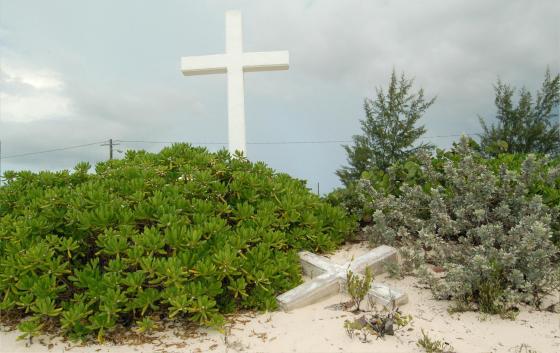
A cross and marker in San Salvador's Landfall Park designate the spot where Christopher Columbus is said to have arrived in the New World. Photo: Pamela LeBlanc, Amerian-Statesman.
|
Source: Statesman.com - Buzzing toward the shore of San Salvador in a dinghy, it's hard to imagine what Christopher Columbus felt when he spotted this island after 33 days of nothing but the endless blue of the Atlantic.
No doubt he saw the same turquoise water, lime green vegetation and mostly flat, scrub-covered land. But he certainly didn't climb out of an inflatable boat onto the dock of a small marina, where I now await the arrival of a tour bus that will show me around this 12-mile island.
Many visitors to the Bahamas never leave the bustling confines of places such as Nassau, where banks and designer shops cram city streets. But of the 700 islands in the Bahamas archipelago, only 50 are inhabited. And of those that are populated, some are just sleepy outposts that most tourists never see.
San Salvador is one of them. Known as the spot where Columbus made landfall in 1492 (although that's debatable) and an offshore population of hammerhead sharks, San Salvador is 200 miles southeast of Nassau.
When Quincy Walker rolls up in his bus (his father, Nat, runs the tour company) and waves happily in our direction, seven of us climb in. We putter out of the marina and past the two resorts on the island, which cater mainly to American scuba divers (Club Med, formerly a U.S. Air Force base, and the Riding Rock Inn). We jostle past a small government medical clinic, a tiny college and an international airport that, believe it or not, hosts direct charter flights from Paris and Montreal.
Any respectable tour of this island covers three main attractions: the lighthouse, the ruins of an old pirate's castle and the spot where Columbus supposedly made landfall. We take the Queens Highway, a 35-mile stretch of pavement built in the 1950s that circles the island. You can't get lost.
Our first stop is the Dixon-Hill lighthouse, built in 1887 and still operating today. Built on land that was once a working plantation, it stands 163 feet above sea level, emitting a double flash every 10 seconds at night.
We file off the bus and through the doors of the 75-foot tower. No one's around, and we climb up a tightly wound staircase to the top, where we check out the view and marvel at the Fresnel prism that aims a kerosene-lit beam visible for 19 miles. Two keepers operate the machinery, which must be rewound every two hours.
Then it's back on the bus, where we rumble past brackish lakes, wild-growing cotton (the last vestiges of the island's plantation history), blink-and-you've-missed-it hamlets and ponciana trees glowing with bright, orange-red blooms.
Next stop, Watling's Castle. Walker tells us about the local pirate who lived here in the 1600s, lighting bonfires along the shoreline to lure ships into the harbor, where he and his men could rob them. Watling, according to local lore, was famous for never pillaging on Sundays. We squeeze through a bramble patch and into crumbling stone ruins of a house, kitchen and slave quarters. A few lizards scamper across the path, and dark clouds scud overhead.
Back on the bus we bounce along, enjoying the cool that the passing thunderstorm has delivered. Most of San Salvador is desolate; Walker tells us that goats sometimes block the road on the sparsely populated east side.
This side is what Columbus would have spotted as he approached from open ocean. He wrote in his journals about an island that was large and level, with a lagoon: "The beauty of these islands surpasses that of any other and as much as the day surpasses the night in splendour."
That's high praise. But it could describe a lot of Bahamian islands, and some argue that Columbus really made landfall on nearby Cat Island, or even Grand Turk, which isn't even officially a part of the Bahamas. Even Columbus himself thought he had arrived in the "Indies," the medieval name for Asia.
Regardless, he renamed the island — which the natives had called Guanahani — San Salvador, or Holy Savior. That wasn't its only name change, either. Long after Columbus had gone, this island became known as Watling's Island, for the pirate whose lair we visited. In 1926, locals officially changed it back to San Salvador.
We pause at Landfall Park in Long Bay, where a towering white cross stands on the beach in tribute to the explorer. Offshore, an underwater memorial gives scuba divers something to ponder from a different perspective.
That's what this place does. It slows you down. It makes you think. It forces you to contemplate events more than 500 years gone. I'll take that over the designer shops and banks any day.
